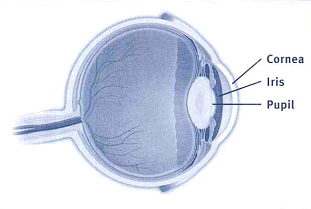Corneal Abrasion
The cornea is the clear front window of the eye. It covers the iris (the colored portion of the eye) and the round pupil. The cornea is composed of five layers. The outermost layer is called the epithelium.

Normal Eye Anatomy
Injuries to the epithelium, such as scratches, cuts, or scrapes, are known as corneal abrasions. Usually, these injuries are caused by fingernail scratches, makeup brushes, paper cuts, or rubbing of the eyes. Sometimes conditions like dry eye can cause abrasions. Symptoms associated with corneal abrasions include tearing, redness, pain, soreness, and blurred vision.
Treatment options for corneal abrasions include patching the injured eye, dilating pupils to relieve pain, wearing special contact lenses that promote healing, taking antibiotics to prevent infection, and using lubricating eyedrops.
Minor abrasions usually heal within a day or two, while larger abrasions take about a week.
Corneal Erosion
Corneal erosion is caused by a loose attachment of the epithelium to the underlying tissue. This often happens at the site of an earlier abrasion. Some patients have an underlying condition called “map-dot-fingerprint dystrophy” that predisposes them to having recurrent corneal erosions.
Symptoms of corneal erosion are similar to those of abrasions: pain, soreness, redness, and blurred vision.
Treatment is the same as for corneal abrasion and may also include saline solution eyedrops or ointments. However, if the erosion keeps occurring, further treatment may be necessary. These treatments may include procedures to remove the damaged epithelium, removal of corneal cells using a laser, or performing an anterior stromal puncture, which involves making tiny holes on the surface of the cornea to promote stronger attachments between the top layer of corneal cells and the layer of the cornea underneath.








